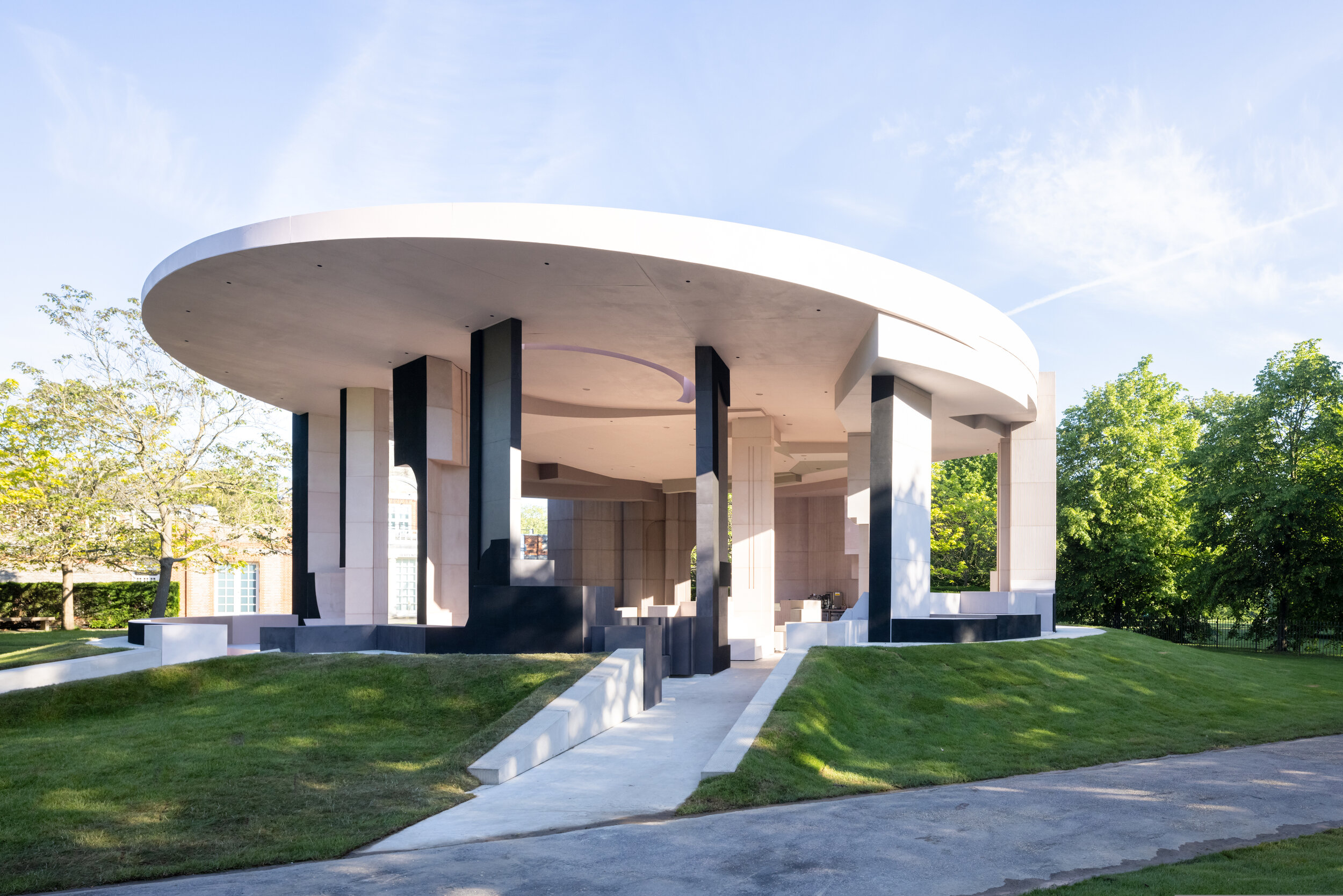Counterspace’s 2021 Serpentine Pavilion opens in Hyde Park
The 2021 Serpentine Pavilion, designed by Sumayya Vally of Counterspace (photo: Iwan Baan).
The 2021 Serpentine Pavilion, designed by Sumayya Valley of the Johannesburg-based practice Counterspace, has opened in Hyde Park.
Formed out of dark cork and prefabricated plywood blocks covered by micro-cement render, supported by a steel frame, the pavilion’s structure is a collage of abstracted architectural elements sampled from around London.
Valley’s research, and the pavilion’s final form, was focused on markets, restaurants, places of worship, bookshops and cultural institutions found in areas of London that are home to diasporic and cross-cultural communities, including Brixton, Hoxton, Hackney, Tower Hamlets, Edgware Road, Barking and Dagenham, Peckham and Notting Hill.
“My practice, and this Pavilion, is centred around amplifying and collaborating with multiple and diverse voices from many different histories; with an interest in themes of identity, community, belonging and gathering,” said Valley in a statement. “The past year has drawn these themes sharply into focus and has allowed me the space to reflect on the incredible generosity of the communities that have been integral to this Pavilion.”
While the origins of the pavilion’s constituent elements have been too heavily edited and abstracted to be fully legible in the final design, they form a landscape of seating, ledges and tables for those who visit the space. In the same vein, Valley has also designed an additional four elements at the scale of furniture, which have been installed in different areas of the city.
The interior of the pavilion is formed from a mixture of dark cork and prefabricated plywood blocks covered with micro-cement render, supported by a recycled steel frame (photo: Iwan Baan).
Originally planned for 2020, Valley’s design was postponed as a result of the pandemic. The structure, which will be open to the public from 11 June to 17 October, has met with qualified praise from critics.
Writing in The Guardian, Olly Wainwright praised the intricacy of the design’s interior. “It should make a great playground for kids, too, with plenty of peephole gaps and hiding places,” he said. “Rather than standing as an object to be admired from afar, like some previous years’ trinkets, this year’s structure has been designed very much from the inside out. Those put off by its looming, rather clunky presence above the tree canopy might be won over by the refined, human-scale detail of what they find inside.”
Speaking with Valley, Wainwright also highlighted the structure’s sampling of architecture from around London and its connections to immigration. “These spaces became important for people to construct a sense of belonging,” Valley told him. “They held mother tongues, mother sounds, recipes from far away. Part of the reason spaces like that come under threat is because we don’t recognise them architecturally as part of our lexicon.”
In The Financial Times, Edwin Heathcote also picked up on this approach, praising the pavilion as “Smart, elegant, inhabitable, politically inflected, it is enjoyable and intimate, a charged space which never overwhelms with its message.”
Heathcote also, however, noted that the elegance of the structure presents its source material in a particular, inflected light. “The radical histories and migrant meeting points haunt the structure as ghosts rather than physical presences, ideas about the city as a place of congregation,” he wrote. “The absence of the real is felt both in the smooth, pastel-toned rendering of the surfaces and the artifice of the abstracted fragments. Unlike the ad hoc spaces adopted and adapted by migrants, the pavilion feels smooth, ironed out.”
This approach drew criticism in The Architects’ Journal, where Robert Wilson queried the impact of the design. “[The] interior of the pavilion is more like an illustration of a space, more stage-set than building,” Wilson wrote. “With all the ledges and benches, and carved-out nooks and crannies, these are undoubtedly great spaces to stop, sit and chat in. But compared with the materially rich, visceral atmosphere of Junya Ishigami 2019 slate-roofed pavilion, the space here is rather bloodless.”
The pavilion’s interior is formed from elements of architecture abstracted from different areas around London (photo: Iwan Baan).
Wilson also noted that the pavilion’s four subsidiary elements installed around the city deviated from the original plan for the structure, in which elements of the design would gradually be removed over time and relocated to different regions of London in a bid to “decentralise” the design. The idea was abandoned after it “proved too logistically difficult”, project curator Natalia Grabowska confirmed.
Questions were also raised by both Wilson and Wainwright about the decision to pour 85-95sqm of concrete to form the pavilion’s foundations, particularly given the Serpentine’s previous commitment to place ecology “at the heart of everything we do”. This decision, critics wrote, exposed a wastefulness at the heart of the annual pavilion programmed. “Why not have a permanent foundation that each architect can reuse, or temporary screw-piles?” asked Wainwright.
The Serpentine, however, insisted that the pavilion is overall “carbon negative by 9,000 tonnes – largely due to the reused steel of the frame”. Speaking in The Architects’ Journal, Valley noted the importance of the conversation around sustainability in architecture. “There’s no defence for not having an agenda on sustainability or the use of materials,” she said.
Despite these critiques, reception to the pavilion has been largely positive, with Valley’s approach and research praised, as well as her ability to channel these into a temporary pavilion structure. “The inspiration of the ephemeral seems perfectly attuned to the impermanence of a pavilion in the park,” concluded Heathcote.
Story source: The Financial Times, The Guardian, and The Architects’ Journal.



